Libyan Army (1951–2011)
The Libyan Army (Arabic: الجيش الليبي) was the branch of the Armed Forces of the Libyan Arab Jamahiriya, the Libyan Arab Republic and the Kingdom of Libya responsible for ground warfare.
| Libyan Army | |
|---|---|
| الجيش الليبي | |
| Active | 1951–2011 |
| Country | |
| Allegiance | Kingdom of Libya (1951–1969) Libyan Arab Republic (1969–1977) Libyan Arab Jamahiriya (1977–2011) |
| Type | Army |
| Size | 40,000 |
| Headquarters | Tripoli |
| Engagements | Egyptian–Libyan War Uganda–Tanzania War Chadian–Libyan War Libyan civil war (2011) |
| Insignia | |
| Identification mark | .svg.png.webp) |
History
The origin of the Royal Libyan Army can be traced back to the Libyan Arab Force (popularly known as the Sanusi Army).[1] Established in August 1940 to fight against the Italians, it was an unit of arab exiles mostly of Cyrenaican origin, although the unit also had a small number of Tripolitanian volunteers and Sudanese men living in Egypt recruited by the future king of Libya, Sayed Idris and led by British officers.[2]
The battalions of the Libyan Army Force were largely used as auxiliaries, constructing defensive works, patrolling, and guarding military installations and prisoners, though they saw combat during the siege of Tobruk.[1][2]
With the withdrawal of Axis forces from Libya in 1943, the Force changed its name to "The Cyrenaica Defence Force" and was disbanded shortly after, with most of it's members joining the newly formed gerdarmerie in the British administred Libya.[1][2]
When Libya gained its independence in 1951, veterans of the original Sanusi army formed the nucleus of the Royal Libyan Army.[1] Until the discovery of oil in the late 1950s, Libya had an insignificant military, given its small population and lack of resources. King Idris deliberately divided his security forces into a regular army and a variety of gendarmerie forces. These gendarmes primary mission was to prevent any dissidence from the Armed Forces.[1]
After the discovery of oil, the Royal Libyan Army was slowly expanded with British assistance and by 1969, it was estimated to have a strength of 6,500 men, about half the size of the armed police (largely recruited from tribes considered loyal by the king).[1]
King Idris, fearing a military led coup largely neglected the Royal Libyan Army,[3] refusing to provide it with tanks, artillery and armored personnel carriers that could potentially be used by mutineers against him,[4] relying instead on the Cyrenaica Defense Force and the Tripolitania Defense Force to protect his reign.[3] He also relied on several lightly armed territorial forces and the mobile National Security Force, which was equipped with armored cars and helicopters.[1] However, they didn't offer any resistance against the 1969 Libyan revolution led by Colonel Muammar Gaddafi.[3][4]
Within a year after the coup, the Libyan Army size increased to 22,000 men, following a recruitment campaign as well the integration of 14,000 men from the disbanded National Security Force and Cyrenaica Defense Force.[5]
After Gaddafi and his fellow Free Officers severed ties with the United States and the United Kingdom, France became the main supplier of weapons to Libya until 1974, when the Soviet Union agreed to sell vast amounts of weapons to Libya, far exceeding the needs of the country armed forces.[6][7] Libyan training and logistics suffered with the sheer amount of equipment purchased and the wide diversity of equipment types.[8]
Though the Libyan army had a large amount of fighting equipment at its disposal, the vast majority was bought in the 1970s and 1980s and was largely obsolete at the time of the 2011 Libyan Civil War.[9] A high percentage remained in storage and a large amount of equipment has also been donated to friendly countries in the Middle East, Africa, South America, and North Korea as well.[7] The Libyan Army was generally regarded as neither efficient nor well trained.[8]
Libyan Arab Jamahiriya period
From the late seventies to the mid to late eighties the army was involved in four major incursions across the Chadian border. The Libyan Army suffered great losses in these conflicts especially that of the Toyota War of 1987 largely due to poor tactics and western aid to Chad.[10][11] All of these incursions were eventually repulsed and Libya no longer occupies Chad. This conflict was known as the Chadian–Libyan War. In February 2011, the First Civil War broke out and several units of the army mutinied and defected to the opposition, with battles taking place across much of the country.
In September 2011, the pre-civil war Libyan Army had been effectively destroyed by a combination of NATO air strikes and combat with rebel forces, with the Libyan Army forces still loyal to Gaddafi abandoning their posts in Tripoli as the rebels took the city, and the remnants of Gaddafi's loyalist army holed up in Sirte, Sabha and Bani Walid.[12]
Strength
In 2009 the International Institute for Strategic Studies estimated that the Ground Forces of the Libyan Arab Jamahiriya numbered 25,000 with an additional, estimated, 25,000 conscripts (total estimated 50,000). The IISS estimated that the ground forces were organised into 11 border defence and 4 security zones, one regime security brigade (the 32nd Khamis Brigade), 10 tank battalions, 10 mechanised infantry battalions, 18 infantry battalions, 6 commando battalions, 22 artillery battalions, 4 surface-to-surface missile brigades and 7 air aefence artillery battalions.[13] Doctrine was a mixture of Egyptian doctrine which was adopted after the 1969 coup and socialist principles derived from the concepts of a People's Army.
Equipment
Tanks and armored fighting vehicles
| Model | Image | Origin | Type | Quantity | Details |
|---|---|---|---|---|---|
| Tanks | |||||
| T-72 | 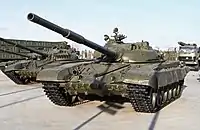 |
Main battle tank | 200[14] | 115 in storage prior to the 2011 Libyan civil war.[14] | |
| T-62 |  |
Main battle tank | 100[14] | 70 in storage prior to the 2011 Libyan civil war.[14] | |
| T-55 |  |
Medium tank | 500[14] | 1,040 T-54/55 in storage prior to the 2011 Libyan civil war.[14] | |
| Reconnaissance vehicles | |||||
| BRDM-2 |  |
Armored scout car | 50[14] | ||
| EE-9 Cascavel | .jpg.webp) |
Armored scout car | 70[14] | ||
| Infantry fighting vehicles | |||||
| BMP-1 |  |
Infantry fighting vehicle | 1,000[14] | ||
| BMD-1[14] |  |
Airborne infantry fighting vehicle | |||
| Armored personnel carriers | |||||
| M113 | _(8288581501).jpg.webp) |
Tracked armored personnel carrier | 28[14] | ||
| BTR-50 |  |
Tracked armored personnel carrier | 750 BTR-50/60 prior to the 2011 Libyan civil war.[14] | ||
| BTR-60 |  |
Wheeled armored personnel carrier | 750 BTR-50/60 prior to the 2011 Libyan civil war.[14] | ||
| EE-11 Urutu | .jpg.webp) |
Wheeled armored personnel carrier | 100[14] | ||
| OT-64 SKOT |  |
Wheeled armored personnel carrier | 67[14] | ||
Artillery
In 2011, the IISS estimated that Libya had more than 2,421 artillery pieces including 444 self-propelled guns, more than 647 towed artillery pieces, 830 multiple rocket launchers, and 500 mortars.[14] A significant amount were put into storage prior to the 2011 civil war.[7]
The IISS also estimated that Libya had 45 FROG-7 tactical ballistic missile launchers in service.[14]
In the 1990s, Libya purchased an estimated number between 5 and 100 Hwasong-6 missiles from North Korea.[15][16] The Libyan government was also interested in buying Hwasong-7 missiles, but apparently never did.[17]
After Gaddafi voluntarily renounced his weapons of mass destruction program in 2003, all Hwasong-6 missiles were scrapped, while Libya was allowed to keep its stockpile of FROG-7 and Scud-B missiles.[16]
| Model | Image | Origin | Caliber | Quantity | Details |
|---|---|---|---|---|---|
| Self-propelled artillery | |||||
| 2S1 Gvozdika |  |
122 mm | 130[14] | Widely used in the 2011 Libyan civil war.[7] | |
| 2S3 Akatsiya |  |
152 mm | 60[14] | Most were retired and stored in the 1990s[7] | |
| 152mm SpGH DANA |  |
152 mm | 80[14] | Retired in the 1990s and placed in storage[7] | |
| M109 |  |
155 mm | 14[14] | Delivered before Gaddafi's coup in 1969. Stored.[7] | |
| Palmaria |  |
155 mm | 160[14] | Widely used in the 2011 Libyan civil war.[7] | |
| Towed artillery | |||||
| M101 howitzer |  |
105 mm | 42+[14] | In storage.[18] | |
| D30 howitzer |  |
122 mm | 190[14] | ||
| D-74 | .jpg.webp) |
122 mm | 60[14] | ||
| M-46 |  |
130 mm | 330[14] | Stored in the 1990s.[7] | |
| M1937 |  |
152 mm | 25[14] | Stored in the 1990s.[7] | |
| Multiple rocket launchers | |||||
| Type 63 |  |
107 mm | 300[14] | ||
| BM-11 |  |
122 mm | 200[14] | ||
| BM-21 |  |
122 mm | 230[14] | ||
| RM-70 |  |
122 mm | 100[14] | Retired and placed in storage in the 1990s[7] | |
| Type 63 130mm multiple rocket launcher | .jpg.webp) |
130 mm | Most were stored prior to the 2011 Libyan civil war.[7] | ||
| Mortars | |||||
| 82-BM-37[19] |  |
82 mm | 428[14] | ||
| 120-PM-43 mortar |  |
120 mm | 48[14] | ||
| M-160 mortar |  |
160 mm | 24[14] | ||
| Tactical ballistic missiles | |||||
| 9K52 Luna-M |  |
45[14] | |||
| Scud-B Scud-C |
 |
80 launchers and 500 missiles[18] Up to 12 launchers and 100 missiles[16] |
Scud-C stockpiles were scrapped after 2003[16][17] | ||
Anti-tank weapons
| Model | Image | Origin | Caliber | Quantity | Details |
|---|---|---|---|---|---|
| Tank destroyers | |||||
| 9P122 |  |
125 mm | 40[14] | ||
| Anti-tank guided missiles | |||||
| 9M14 Malyutka |  |
125 mm | 620[14] | ||
| 9K111 Fagot | 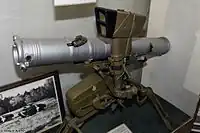 |
120 mm | Prior to the 2011 civil war the IISS estimated the Libyan army had 1,940 Fagot and Konkurs missiles.[14] | ||
| 9M113 Konkurs | .jpg.webp) |
135 mm | Prior to the 2011 civil war the IISS estimated the Libyan army had 1,940 Fagot and Konkurs missiles.[14] | ||
| MILAN |  |
115 mm | 400[14] | ||
| 9M133 Kornet | .jpg.webp) |
152 mm | Purchased prior to the 2011 Libyan civil war.[20] | ||
| 9M123 Khrizantema |  |
150 mm | 150[15] | Purchased prior to the 2011 Libyan civil war.[21] | |
| Recoilless rifles | |||||
| M40 recoilless rifle | 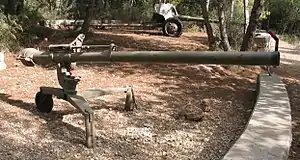 |
105 mm | 200[14] | ||
| Carl Gustav recoilless rifle | .jpg.webp) |
84 mm | 400[14] | ||
| Rocket launchers | |||||
| RPG-7 |  |
40 mm | 2,300[14] | ||
Anti-air weapons
In 1968, King Idris signed a contract with the British for the installation of an air defense system to be delivered in five years at a cost of US$300 million. The British would supply anti-air missile systems, radars, and provide training as well, but these plans were cancelled after the monarchy was overthrown in 1969, and Gaddafi sought Soviet assistance instead.[4]
In 2011 the IISS estimated that the Libyan army operated more than 424 surface-to-air missile systems, and 490 anti-aircraft guns (both towed and self-propelled),[14] while the Air Defense Command (established in 1973)[22] operated more than 216 SAM systems, as well some AA guns.[23] By 2009, Libyan land-based air defenses were largely obsolete, however they were amongst the largest in the Middle East.[22]
Most of Libya's air defence systems were destroyed during the civil war,[24] how much, if any, remained intact afterwards is unknown. Many of the anti-aircraft guns captured by rebel forces were turned on Libyan Army ground forces after being bolted onto pick up trucks.[25]
| Model | Image | Origin | Type | Quantity | Details |
|---|---|---|---|---|---|
| Surface-to-air missiles | |||||
| Crotale |  |
Short range mobile SAM | 24[14] | Operated by the Army.[14] | |
| S-75 Volkhov |  |
Long range towed SAM | 108[23] | NATO reporting name: SA-2 Guideline. Operated by the Air Defense Command.[23] | |
| S-125 Pechora |  |
Short range static SAM | 36[23] | NATO reporting name: SA-3 Goa. Operated by the Air Defense Command.[23] | |
| S-200 Angara/Vega/Dubna |  |
Long range static SAM | NATO reporting name: SA-5 Gammon. Operated by the Air Defense Command.[23] | ||
| 2K12 Kub | 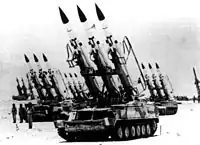 |
Medium range mobile SAM | NATO reporting name: SA-6 Gainful. Operated by the Air Defense Command.[23] | ||
| 9K32 Strela-2 |  |
Short range man-portable air defense system | 400[14] | NATO reporting name: SA-7 Grail. Operated by the Army[14] | |
| 9K33 Osa | 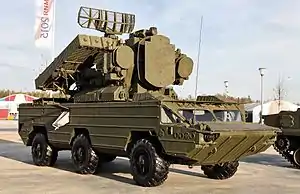 |
Short range mobile SAM | NATO reporting name: SA-8 Gecko. Operated by the Air Defense Command.[23] | ||
| 9K31 Strela-1 |  |
Short range mobile SAM | NATO reporting name: SA-9 Gaskin. Operated by the Army.[14] | ||
| 9K35 Strela-10 |  |
Short range mobile SAM | NATO reporting name: SA-13 Gopher. Operated by the Army.[14] | ||
| 9K338 Igla-S | .jpg.webp) |
Short range SAM | 482[15] | NATO reporting name: SA-24 Grinch. Purchased in 2004 and delivered between 2006 and 2008 for vehicle mounted launchers.[15] | |
| Anti-aircraft guns | |||||
| ZPU-2 |  |
14.5×144 mm towed anti-aircraft gun | 100[14] | ||
| ZU-23-2[26] |  |
23 mm towed anti-aircraft gun | |||
| Bofors 40 mm Automatic Gun L/70[26] |  |
40 mm towed anti-aircraft gun | 50[14] | Sold by Yugoslavia[27] | |
| AZP S-60[26] | 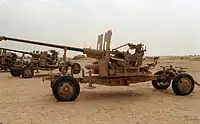 |
57 mm towed anti-aircraft gun | 90[14] | ||
| ZSU-23-4[26] | 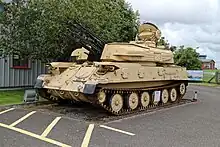 |
23 mm self-propelled anti-aircraft gun | 250[14] | ||
| M53/59 Praga[14][26] |  |
30 mm self-propelled anti-aircraft gun | |||
Small arms
Small arms reported in service included TT pistol, Beretta M12, FN P90, SKS, AK-47, AK-74, Pistol Mitralieră model 1963/1965 and AKM assault rifles, the FN F2000, Soviet RPD machine gun, RPK machine gun, PK machine guns, DShK heavy machine gun, KPV heavy machine guns, SG-43 Goryunov, and a number of RPG type and anti-aircraft missile systems: RPG-2, RPG-7, 9K32 Strela-2.
Combat experience
A sharp series of border clashes occurred with Egypt in 1977, and Libyan forces were flown into Uganda in 1978 in an unsuccessful effort to defend Idi Amin's Uganda against invading Tanzanian forces. In addition, the Libyans conducted a series of campaigns in Northern Chad since 1980, launching a campaign against Chad that year and again in 1983. In April 1987, Libya suffered a disastrous defeat in Chad, losing nearly a quarter of its invasion force.
Egypt
On 19 July 1977, after a protest march by Libyans was stopped by Egyptian border guards, Libyan artillery units fired into Egypt. After further border violations were alleged by both sides, fighting escalated on the same day with an artillery duel, and, two days later, a drive along the coast by Egyptian armor and infantry during which the Libyan army was engaged. Egypt claimed successful surprise air strikes against the Libyan air base at Al Adem, just south of Tobruk, and surface-to-air missile batteries and radar stations were knocked out as well.
When the Egyptians withdrew on 24 July, most foreign analysts agreed that the Egyptian units had prevailed, although Libyan forces responded more effectively than had been expected. Libyan army hailed the encounter as a victory, using the fight as a justification for further purchases of modern armaments.
Uganda
In the case of Uganda, Libya had intervened on Idi Amin's behalf during his first confrontation with neighboring Tanzania in 1972 by airlifting a contingent of 4000 troops. During the invasion of Uganda by Tanzanian troops and Ugandan exiles in 1978, a new Libyan force estimated at 2,000 to 2,500 was sent, assisting in the defence of Entebbe and Kampala by covering road junctions with armored equipment.
Unprepared and undermotivated Libyan troops were quickly routed in attacks by foot soldiers. As many as 600 Libyans were estimated to have been killed during the Ugandan operation, and the remainder were hurriedly withdrawn. The troops had been led to believe that they were being airlifted into Uganda for training exercises with Ugandan units.
Chad
After nearly two decades, Col. Muammar Gaddafi's attempts to annex Northern Chad ended in 1987. In just the first three months of 1987, Libya lost almost all the territory it had held in Chad, between $500 million and $1 billion in weapons and one-third of its 15,000 troops. Over 4,494 Libyan soldiers were killed by Chad's forces between January and March 1987.
The Libyan Army was defeated by a force substantially inferior in numbers and equipment. Chad's victory was the result of a combination of Western funding, weapons and intelligence and Chadian courage, tactics and leadership. France provided air cover and troops to protect the Chadian rear areas, while the USA provided $240 million in equipment and weapons. The U.S. also contributed $75 million in emergency military aid, including transport aircraft and air defence systems.
The Chad forces displayed some remarkable tactical innovations: they used Toyota all-terrain vehicles, lightly armored French-made Panhard cars, and Milan antitank and Stinger antiaircraft missiles to destroy Libyan tanks and planes.
Libyan civil war


In 2011 protests against the rule of Gaddafi started in Libya. They were inspired by similar protests in other Arab countries. Gaddafi used police and mercenary forces to violently suppress the protest.[28] This resulted in an armed uprising in Libya between pro-government and anti-government forces. Parts of the army joined the rebels and weapon depots were plundered by protesters.[29] After initial advances by the rebels, the Libyan Army began a counteroffensive and started pushing back the rebel fighters.[30][31] On 17 March 2011, the United Nations Security Council passed United Nations Security Council Resolution 1973, authorizing the use of "all necessary means" to protect civilians in Libya, "excluding a foreign occupation force".[32] On Saturday, 19 March 2011, France began enforcement of the resolution by deploying French fighter aircraft over Libyan airspace.[33]
- First Battle of Benghazi 17–20 February
- Tripoli clashes 17–25 February
- Battle of Misrata 18 February – 15 May
- First Battle of Zawiya 24 February – 10 March
- 2011 Nafusa Mountain Campaign 1 March – 18 August
- First Battle of Brega 2 March
- Battle of Ra's Lanuf 4–12 March
- Battle of Bin Jawad 6 March
- Second Battle of Brega 13–15 March
- Battle of Ajdabiya 15–26 March
- Second Battle of Benghazi 19–20 March
- First Gulf of Sidra offensive 26–30 March
- Third Battle of Brega 31 March – 7 April
- Cyrenaican desert campaign 3 April – 12 June
- Battle of Brega–Ajdabiya road 8 April – 21 May
- Battle of Wazzin 20 April – 29 July
- Battle of the Misrata frontline 16 May – 19 August
- 2011 Sabha clashes 8–13 June
- Zliten uprising 9–16 June
- Zawiya raid 11–12 June
- Battle of Zliten 21 July – 19 August
- Fourth Battle of Brega 14 July – 22 August
- Fezzan campaign 17 July – 27 September
- 2011 Msallata clashes 3–9 August
- Battle of Tawergha 11–13 August
- Battle of Gharyan 13–18 August
- Second Battle of Zawiya 13–20 August
- 2011 Ras Ajdir clashes 13–26 August
- 2011 Libyan rebel coastal offensive 13–28 August
- Douz skirmish 19–20 August
- Battle of Tripoli 20–28 August
- Second Gulf of Sidra offensive 22 August – 20 October (End of the Libyan civil war)
- Battle of Bani Walid 9 September – 17 October
- Battle of Sirte 20 October
References
- Metz & Library of Congress 1989, p. 241.
- Marchant, Charlotte (15 August 2022). "The National Archives - The Libyan Arab Force during the Second World War". The National Archives blog. Retrieved 14 September 2023.
- St. John 2023, p. 88.
- Metz & Library of Congress 1989, p. 242.
- Metz & Library of Congress 1989, p. 242−243.
- Metz & Library of Congress 1989, p. 243.
- Mitzer, Stijn; Oliemans, Joost. "Gaddafi's Massive Artillery Force That Kept On Fighting A Year After His Death". Oryx. Retrieved 14 September 2023.
- Cordesman 2004, pp. 71−72.
- Mouterde, Perrine (9 March 2011). "Obsolete and inept, yet Gaddafi's forces hang on". France 24. Retrieved 14 September 2023.
- Metz & Library of Congress 1989, pp. 248−251.
- Powell 2020, p. 328.
- Harding, Luke; Davies, Lizzy (22 August 2011). "Libya: Gaddafi forces battle on after rebels enter Tripoli". The Guardian. London.
- IISS, The Military Balance 2009, p. 256
- Military Balance 2011, p. 320.
- "SIPRI Arms Transfers Database | SIPRI". www.sipri.org. Stockholm International Peace Research Institute. Retrieved 16 September 2023.
- Cordesman 2004, pp. 453−454.
- Bechtol 2010, p. 59.
- Libya (PDF) (Report). Institute for National Strategic Studies. Archived from the original (PDF) on 8 April 2011.
- Hogg 1988, p. 770.
- Bouckaert, Peter. "Refworld | Qaddafi's Great Arms Bazaar". United Nations High Commissioner for Refugees. Human Rights Watch. Retrieved 15 September 2023.
- "Когда говорят премьеры, пушки молчат". Коммерсантъ. 10 September 2011. Retrieved 21 November 2014.
- Cordesman & Nerguizian 2009, p. 72.
- Military Balance 2011, p. 321.
- "Libya: Gaddafi's air defences 'knocked out'". 21 March 2011.
- "DIY Weapons of the Libyan Rebels". The Atlantic. Retrieved 21 November 2014.
- Cordesman 2004, p. 101.
- Curtis & Library of Congress 1992, p. 274.
- "Libya protests: More than 100 killed as army fires on unarmed demonstrators". The Guardian. London. 20 February 2011.
- "Libya rebels gain arms, defectors". Boston.com. 28 February 2011. Retrieved 10 March 2011.
- "Rebel forces retreat from Ras Lanuf". Al Jazeera. 10 March 2011. Retrieved 10 March 2011.
- "Rebel push stalls outside Ras Lanuf". Al Jazeera. 10 March 2011. Retrieved 10 March 2011.
- "Security Council Approves No-Fly Zone over Libya, Authorizing All Necessary Measures to Protect Civilians". United Nations. Archived from the original on 19 March 2011. Retrieved 20 March 2011.
- "French military jet opens fire in Libya". BBC. 19 March 2011. Retrieved 20 March 2011.
Bibliography
- Metz, Helen Chapin; Library of Congress, Federal Research Division (1989). Libya : a country study (PDF). Washington, D.C.: Federal Research Division, Library of Congress : For sale by the Supt. of Docs., U.S. G.P.O., 1989. Retrieved 14 September 2023.
- St. John, Ronald Bruce (15 March 2023). Historical Dictionary of Libya. Rowman & Littlefield Publishers. ISBN 9781538157428.
- Cordesman, Anthony H. (30 September 2004). The Military Balance in the Middle East. Bloomsbury Publishing USA. ISBN 978-0-313-02676-8.
- Powell, Nathaniel K. (17 December 2020). France's Wars in Chad: Military Intervention and Decolonization in Africa. Cambridge University Press. ISBN 978-1-108-48867-9.
- International Institute for Strategic Studies (2011). The Military Balance 2011. Routledge. ISBN 978-1-85743-606-8.
- Hogg, Ian V., ed. (1 January 1988). Jane's Infantry Weapons, 1988-89. Jane's Information Group. ISBN 978-0-7106-0857-4.
- Bechtol, Bruce E. (October 2010). Defiant Failed State: The North Korean Threat to International Security. Potomac Books, Inc. ISBN 978-1-59797-531-5.
- Cordesman, Anthony H.; Nerguizian, Aram (2009). The North African Military Balance: Force Developments in the Maghreb. CSIS. ISBN 978-0-89206-552-3.
- Curtis, Glenn E.; Library of Congress, Federal Research Division (1992). Yugoslavia : a country study (PDF). Washington, D.C.: Federal Research Division, Library of Congress : For sale by the Supt. of Docs., U.S. G.P.O., [1992].
![]() This article incorporates text from this source, which is in the public domain. Helen Chapin Metz (1989). Libya: A Country Study. Federal Research Division.
This article incorporates text from this source, which is in the public domain. Helen Chapin Metz (1989). Libya: A Country Study. Federal Research Division.
Further reading
- Kenneth M. Pollack, Arabs at War: Military Effectiveness 1948–91, University of Nebraska Press, Lincoln and London, 2002, ISBN 0-8032-3733-2